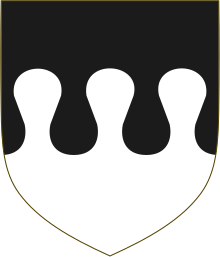Federigo Fregoso
Federigo Fregoso (* around 1480 in Genoa ; † November 11, 1541 in Gubbio ) was an Italian Catholic clergyman, writer and military leader of the 16th century .
Life
Federigo Fregoso was born the second son of Agostino Fregoso, Condottiere of the Republic of Genoa in 1488 during the reign of Ludovico Sforza and of Gentile da Montefeltro , daughter of Federico da Montefeltro , Duke of Urbino .
Fregoso spent his youth at the court of his uncle Guidobaldo I da Montefeltro , successor of his father Federico as Duke of Urbino from 1482. At the court of Urbino, Federigo received a comprehensive classical education and made friends with humanistic scholars such as Pietro Bembo and Baldassare Castiglione . After his ordination as a priest he began his ecclesiastical career in 1507 when he by Pope Julius II. The office of the Archbishop of Salerno was awarded. However , Federigo could not actually lead the diocese he was given , since the House of Fregoso in Genoa represented the interests of King Louis XII. represented by France , Salerno was under Spanish rule as part of the Kingdom of Naples . Because of Fregoso's sympathy for the French crown, the Spanish regent Ferdinand II refused to recognize the new archbishop - so the Pope consecrated Federigo Fregoso as Bishop of Gubbio .
In 1510 clashes broke out in Genoa between the rival factions of the Ghibellines and Guelphs , which ended with the victory of the Ghibelline family Adorno. The Guelfan Fregosi, including Federigo, were exiled and forced to seek refuge in Rome. Three years later, after the Adorni suffered severe military defeats, the House of Fregoso returned to Genoa and secured Guelf rule over the Republic of Genoa with other houses. His older brother Ottaviano was elected Doge of Genoa, and Federigo took over the leadership of the army as his brother's closest advisor to protect the Genoese Republic against internal dangers such as renewed uprisings by the Adorni and Fieschi as well as the oppression of the Barbaresque corsairs .
The corsair Kurtoğlu Muslihiddin Reis blocked the Ligurian Sea with a squadron of privateers and had captured eighteen Genoese merchants within a few days. After Federigo Fregoso had taken command of the Genoese fleet, in which Andrea Doria also served, he surprised Kurtoğlu off Bizerta , landed on the island of Djerba , occupied the island and returned to Genoa with large booty.
Doge Ottaviano Fregoso had recognized King Francis I of France as lord of Genoa and from then on led the fate of the republic as governor in French service. In 1522, his Spanish opponent in the Italian wars , Emperor Charles V , besieged the city. Federigo Fregoso led the defense and was wounded during the fighting. The Spanish assaulted Genoa, arrested the governor and Fregoso was forced to seek safety on a French ship. Francis I gave him a warm welcome in France and appointed him head of the Abbey of Saint-Bénigne near Dijon. Here Fregoso devoted himself in particular to the study of ancient Greek and Hebrew, but after disputes with the monks who complained about his severity, he returned to Italy.
In 1529 he finally renounced the title of Archbishop of Salerno and remained Bishop of Gubbio. In 1539 Pope Paul III appointed him . the cardinal priests and showed him the Roman church of Santi Giovanni e Paolo as a titular church to.
In the late years of his life, Federigo Fregoso wrote several literary works, including the "Trattato dell'Orazione" (Treatise on Prayer), which was published posthumously in 1543 .
Federigo Fregoso died on November 11, 1541 in Gubbio and was buried there in the Dom Santi Mariano e Giacomo.
literature
- Giampiero Brunelli: Fregoso, Federico. In: Fiorella Bartoccini (ed.): Dizionario Biografico degli Italiani (DBI). Volume 50: Francesco I Sforza-Gabbi. Istituto della Enciclopedia Italiana, Rome 1998.
- Louis Bréhier : Federigo Fregoso . In: Catholic Encyclopedia , Volume 6, Robert Appleton Company, New York 1909.
Web links
- Fregóso, Federico. In: Salvador Miranda : The Cardinals of the Holy Roman Church. ( Florida International University website), accessed August 22, 2017.
- Biografia dell'Arcivescovo Federico Fregoso. In: Elenco dei Vescovi a Salerno. Archdiocese of Salerno-Campagna-Acerno , 2019, accessed February 14, 2020 (Italian).
| predecessor | Office | successor |
|---|---|---|
| Claude de Charmes |
Abbot of Saint-Bénigne 1525–1541 |
Nicolas Jeannin |
| Antonio Ferrero |
Bishop of Gubbio 1508–1541 |
Pietro Bembo |
| Giovanni de Vera |
Archbishop of Salerno 1507–1533 |
Niccolò Ridolfi |
| personal data | |
|---|---|
| SURNAME | Fregoso, Federigo |
| BRIEF DESCRIPTION | Italian cardinal, Archbishop of Salerno and Bishop of Gubbio |
| DATE OF BIRTH | around 1480 |
| PLACE OF BIRTH | Genoa |
| DATE OF DEATH | November 11, 1541 |
| Place of death | Gubbio |
